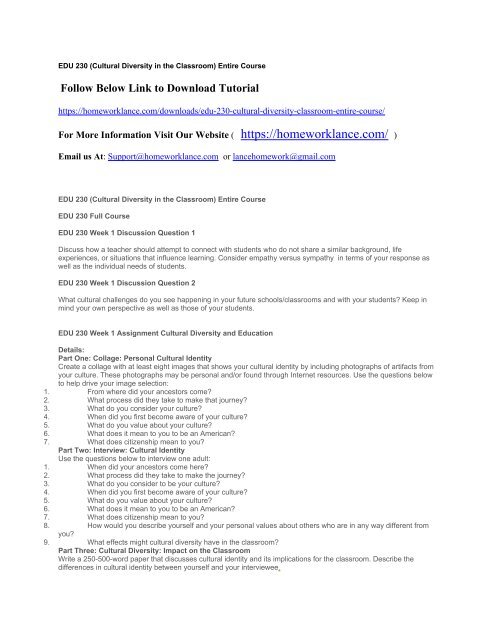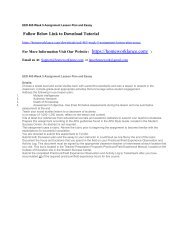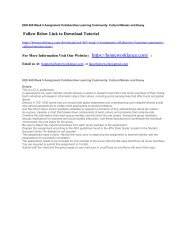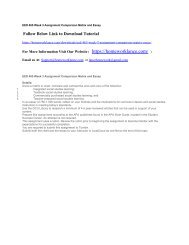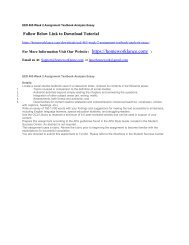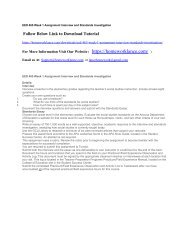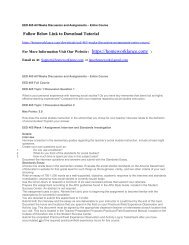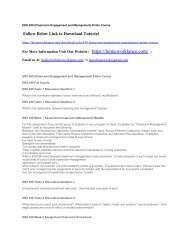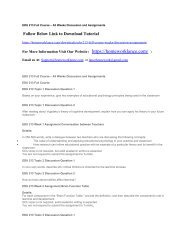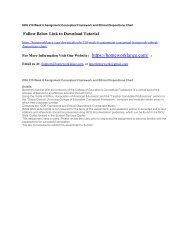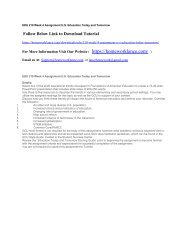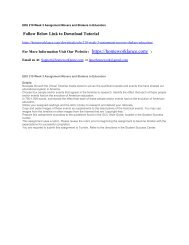EDU 230 (Cultural Diversity in the Classroom) Entire Course
EDU 230 (Cultural Diversity in the Classroom) Entire Course
EDU 230 (Cultural Diversity in the Classroom) Entire Course
Create successful ePaper yourself
Turn your PDF publications into a flip-book with our unique Google optimized e-Paper software.
<strong>EDU</strong> <strong>230</strong> (<strong>Cultural</strong> <strong>Diversity</strong> <strong>in</strong> <strong>the</strong> <strong>Classroom</strong>) <strong>Entire</strong> <strong>Course</strong><br />
Follow Below L<strong>in</strong>k to Download Tutorial<br />
https://homeworklance.com/downloads/edu-<strong>230</strong>-cultural-diversity-classroom-entire-course/<br />
For More Information Visit Our Website ( https://homeworklance.com/ )<br />
Email us At: Support@homeworklance.com or lancehomework@gmail.com<br />
<strong>EDU</strong> <strong>230</strong> (<strong>Cultural</strong> <strong>Diversity</strong> <strong>in</strong> <strong>the</strong> <strong>Classroom</strong>) <strong>Entire</strong> <strong>Course</strong><br />
<strong>EDU</strong> <strong>230</strong> Full <strong>Course</strong><br />
<strong>EDU</strong> <strong>230</strong> Week 1 Discussion Question 1<br />
Discuss how a teacher should attempt to connect with students who do not share a similar background, life<br />
experiences, or situations that <strong>in</strong>fluence learn<strong>in</strong>g. Consider empathy versus sympathy <strong>in</strong> terms of your response as<br />
well as <strong>the</strong> <strong>in</strong>dividual needs of students.<br />
<strong>EDU</strong> <strong>230</strong> Week 1 Discussion Question 2<br />
What cultural challenges do you see happen<strong>in</strong>g <strong>in</strong> your future schools/classrooms and with your students? Keep <strong>in</strong><br />
m<strong>in</strong>d your own perspective as well as those of your students.<br />
<strong>EDU</strong> <strong>230</strong> Week 1 Assignment <strong>Cultural</strong> <strong>Diversity</strong> and Education<br />
Details:<br />
Part One: Collage: Personal <strong>Cultural</strong> Identity<br />
Create a collage with at least eight images that shows your cultural identity by <strong>in</strong>clud<strong>in</strong>g photographs of artifacts from<br />
your culture. These photographs may be personal and/or found through Internet resources. Use <strong>the</strong> questions below<br />
to help drive your image selection:<br />
1. From where did your ancestors come?<br />
2. What process did <strong>the</strong>y take to make that journey?<br />
3. What do you consider your culture?<br />
4. When did you first become aware of your culture?<br />
5. What do you value about your culture?<br />
6. What does it mean to you to be an American?<br />
7. What does citizenship mean to you?<br />
Part Two: Interview: <strong>Cultural</strong> Identity<br />
Use <strong>the</strong> questions below to <strong>in</strong>terview one adult:<br />
1. When did your ancestors come here?<br />
2. What process did <strong>the</strong>y take to make <strong>the</strong> journey?<br />
3. What do you consider to be your culture?<br />
4. When did you first become aware of your culture?<br />
5. What do you value about your culture?<br />
6. What does it mean to you to be an American?<br />
7. What does citizenship mean to you?<br />
8. How would you describe yourself and your personal values about o<strong>the</strong>rs who are <strong>in</strong> any way different from<br />
you?<br />
9. What effects might cultural diversity have <strong>in</strong> <strong>the</strong> classroom?<br />
Part Three: <strong>Cultural</strong> <strong>Diversity</strong>: Impact on <strong>the</strong> <strong>Classroom</strong><br />
Write a 250-500-word paper that discusses cultural identity and its implications for <strong>the</strong> classroom. Describe <strong>the</strong><br />
differences <strong>in</strong> cultural identity between yourself and your <strong>in</strong>terviewee.
Given <strong>the</strong> <strong>in</strong>terviewee’s responses to questions 8 and 9 and your own responses to <strong>the</strong>se same questions, discuss<br />
<strong>the</strong> possible effects and advantages of hav<strong>in</strong>g culturally diverse students <strong>in</strong> <strong>the</strong> classroom.<br />
Submit your collage, <strong>in</strong>terview questions with answers, and paper as one deliverable.<br />
Prepare this assignment accord<strong>in</strong>g to <strong>the</strong> GCU guidel<strong>in</strong>es found <strong>in</strong> <strong>the</strong> GCU Style Guide, located <strong>in</strong> <strong>the</strong> Student<br />
Success Center.<br />
This assignment uses a rubric. Please review <strong>the</strong> rubric prior to beg<strong>in</strong>n<strong>in</strong>g <strong>the</strong> assignment to become familiar with <strong>the</strong><br />
expectations for successful completion.<br />
You are not required to submit this assignment to Turnit<strong>in</strong>.<br />
<strong>EDU</strong> <strong>230</strong> Week 2 Discussion Question 1<br />
Is it important for parents to know what is happen<strong>in</strong>g at school, specifically <strong>in</strong> <strong>the</strong>ir own children’s classrooms? Why<br />
or why not?<br />
<strong>EDU</strong> <strong>230</strong> Week 2 Discussion Question 2<br />
What role does technology have <strong>in</strong> <strong>the</strong> school’s communication with parents/guardians? How do you believe this will<br />
<strong>in</strong>crease <strong>in</strong> <strong>the</strong> com<strong>in</strong>g years?<br />
<strong>EDU</strong> 239 Week 2 Assignment Home and School Connection<br />
Part One: Parent/Guardian Interview<br />
Interview two parents/guardians from different families with school-age children (consider diversity). One of those<br />
parents/guardians may be you. Record <strong>the</strong> responses to <strong>the</strong> follow<strong>in</strong>g questions:<br />
1. How do you f<strong>in</strong>d out about <strong>the</strong> activities and decisions of your school?<br />
2. Do you th<strong>in</strong>k that <strong>the</strong> school strives to meet <strong>the</strong> needs of its students? Is it successful <strong>in</strong> this venture? Why<br />
or why not?<br />
3. Do you feel welcome at <strong>the</strong> school? Why or why not? Provide an example.<br />
4. What are <strong>the</strong> strengths and weaknesses of communication from <strong>the</strong> school?<br />
5. How would you respond to an <strong>in</strong>crease of electronic communication?<br />
6. Would better home and school communication improve your child’s education? Why or why not?<br />
Part Two: Adm<strong>in</strong>istrator Questions<br />
After <strong>in</strong>terview<strong>in</strong>g <strong>the</strong> parents/guardians, construct a series of five to seven questions you could ask adm<strong>in</strong>istrators<br />
about policies of communication to parents/guardians. Consider <strong>the</strong> follow<strong>in</strong>g:<br />
1. Strengths and weaknesses<br />
2. Electronic communication<br />
3. Best practices<br />
4. Future trends<br />
5. Challenges<br />
Part Three: Faculty Presentation<br />
Create a 10-15 slide PowerPo<strong>in</strong>t or Prezi presentation to deliver at a faculty meet<strong>in</strong>g. Include <strong>the</strong> follow<strong>in</strong>g:<br />
1. Describe at least three strategies for improv<strong>in</strong>g home and school communication. Draw upon <strong>the</strong> <strong>in</strong>formation<br />
obta<strong>in</strong>ed from Part One: Parent/Guardian Interview and Part Two: Adm<strong>in</strong>istrator Questions.<br />
2. Include o<strong>the</strong>r resources as desired.<br />
3. Include slide notes and images/illustrations.<br />
In addition, <strong>in</strong>clude a title slide, reference slide, slide notes, key phrases, and images/illustrations. Title slide and<br />
reference slide are not <strong>in</strong>cluded <strong>in</strong> <strong>the</strong> 10-15 slides required.<br />
Submit <strong>the</strong> Parent/Guardian Interview, Adm<strong>in</strong>istrator Questions, and Faculty Presentation as one deliverable.<br />
While GCU format is not required for <strong>the</strong> body of this assignment, solid academic writ<strong>in</strong>g is expected, and <strong>in</strong>-text<br />
citations and references should be presented us<strong>in</strong>g GCU documentation guidel<strong>in</strong>es, which can be found <strong>in</strong> <strong>the</strong> GCU<br />
Style Guide, located <strong>in</strong> <strong>the</strong> Student Success Center.<br />
This assignment uses a rubric. Please review <strong>the</strong> rubric prior to beg<strong>in</strong>n<strong>in</strong>g <strong>the</strong> assignment to become familiar with <strong>the</strong><br />
expectations for successful completion.<br />
You are not required to submit this assignment to Turnit<strong>in</strong>.<br />
<strong>EDU</strong> <strong>230</strong> Week 3 Discussion Question 1<br />
Why should teachers seek to understand <strong>the</strong> perspectives of <strong>the</strong>ir students’ cultures, customs, and traditions?
<strong>EDU</strong> <strong>230</strong> Week 3 Discussion Question 2<br />
What is a current multicultural practice be<strong>in</strong>g implemented <strong>in</strong> your state or local school district? Do you feel this<br />
approach encompasses all cultures <strong>in</strong> your community? Why or why not?<br />
<strong>EDU</strong> <strong>230</strong> Week 3 Assignment CLC – Historical Perspectives of Multiculturalism – Understand<strong>in</strong>g Educational<br />
Movements<br />
Details:<br />
This is a Collaborative Learn<strong>in</strong>g Community assignment.<br />
Your <strong>in</strong>structor will assign a specific educational movement to your group from <strong>the</strong> follow<strong>in</strong>g list:<br />
Women’s Movement<br />
Ethnic/<strong>Cultural</strong> Movement<br />
Standards Movement<br />
Choice/Accountability Movement<br />
Create a 10-15 slide PowerPo<strong>in</strong>t or Prezi presentation that chronicles <strong>the</strong> historical progression of multicultural<br />
education by exam<strong>in</strong><strong>in</strong>g <strong>the</strong> assigned educational movement. The 10-15 slides are to <strong>in</strong>clude <strong>the</strong> follow<strong>in</strong>g:<br />
Describe <strong>the</strong> movement <strong>in</strong>clud<strong>in</strong>g when <strong>the</strong> movement occurred or is occurr<strong>in</strong>g as well as any biases or stereotypes;<br />
Describe 2-3 legal actions and <strong>the</strong>ir effect on education; and<br />
Describe strategies for design<strong>in</strong>g <strong>in</strong>struction and assessment that elim<strong>in</strong>ates bias and overcomes stereotypes.<br />
In addition, <strong>in</strong>clude a title slide, reference slide, slide notes, key phrases, and images/illustrations. Title slide and<br />
reference slide are not <strong>in</strong>cluded <strong>in</strong> <strong>the</strong> 10-15 slides required.<br />
While GCU format is not required for <strong>the</strong> body of this assignment, solid academic writ<strong>in</strong>g is expected, and <strong>in</strong>-text<br />
citations and references should be presented us<strong>in</strong>g GCU documentation guidel<strong>in</strong>es, which can be found <strong>in</strong> <strong>the</strong> GCU<br />
Style Guide, located <strong>in</strong> <strong>the</strong> Student Success Center.<br />
This assignment uses a rubric. Please review <strong>the</strong> rubric prior to beg<strong>in</strong>n<strong>in</strong>g <strong>the</strong> assignment to become familiar with <strong>the</strong><br />
expectations for successful completion.<br />
You are not required to submit this assignment to Turnit<strong>in</strong>.<br />
<strong>EDU</strong> <strong>230</strong> Week 3 Assignment <strong>Cultural</strong> Identifiers – Challenges and Responses<br />
Details:<br />
Complete <strong>the</strong> “<strong>Cultural</strong> Identifiers – Challenges and Responses” document found <strong>in</strong> <strong>the</strong> Topic Materials. Use<br />
complete sentences and be specific <strong>in</strong> your description of <strong>the</strong> potential challenges and appropriate responses for<br />
each example. Consider how you would handle <strong>the</strong> circumstance as a future teacher so that you would offer <strong>the</strong> best<br />
learn<strong>in</strong>g experience for all students.<br />
For each of <strong>the</strong> eleven examples, select from <strong>the</strong> follow<strong>in</strong>g list of cultural identifiers: ability, age, ethnicity, gender,<br />
race, religion, sexual orientation, socioeconomic status (class), body image (“lookism”), educational background,<br />
academic/social achievement, family of orig<strong>in</strong>, family make up, geographic/regional background, language, learn<strong>in</strong>g<br />
style, beliefs (political, social, religious), or globalism/<strong>in</strong>ternationalism.<br />
While GCU format is not required for <strong>the</strong> body of this assignment, solid academic writ<strong>in</strong>g is expected, and <strong>in</strong>-text<br />
citations and references should be presented us<strong>in</strong>g GCU documentation guidel<strong>in</strong>es, which can be found <strong>in</strong> <strong>the</strong> GCU<br />
Style Guide, located <strong>in</strong> <strong>the</strong> Student Success Center.<br />
You are not required to submit this assignment to Turnit<strong>in</strong>.<br />
<strong>EDU</strong> <strong>230</strong> Week 4 Discussion Question 1<br />
What challenges do today’s teachers have <strong>in</strong> <strong>the</strong>ir classrooms that yesterday’s teachers did not experience?<br />
<strong>EDU</strong> <strong>230</strong> Week 4 Discussion Question 2<br />
Based on <strong>the</strong> assigned read<strong>in</strong>gs, <strong>in</strong> your op<strong>in</strong>ion, what is <strong>the</strong> most important transformation to happen <strong>in</strong> schools?<br />
Why?<br />
<strong>EDU</strong> <strong>230</strong> Week 4 Assignment Teach<strong>in</strong>g Strategies<br />
Details:<br />
Complete <strong>the</strong> “Teach<strong>in</strong>g Strategies” document. The document provides four scenarios regard<strong>in</strong>g second language<br />
acquisition for English Language Learners. After read<strong>in</strong>g each scenario, do <strong>the</strong> follow<strong>in</strong>g:<br />
1. Evaluate each scenario. Determ<strong>in</strong>e what development stage of second language acquisition is represented<br />
and provide <strong>the</strong> rationale for your choice.
2. Describe teach<strong>in</strong>g strategies that can be used to support <strong>the</strong> student and provide rationales for your choices.<br />
While GCU format is not required for <strong>the</strong> body of this assignment, solid academic writ<strong>in</strong>g is expected, and <strong>in</strong>-text<br />
citations and references should be presented us<strong>in</strong>g GCU documentation guidel<strong>in</strong>es, which can be found <strong>in</strong> <strong>the</strong> GCU<br />
Style Guide, located <strong>in</strong> <strong>the</strong> Student Success Center.<br />
This assignment uses a rubric. Please review <strong>the</strong> rubric prior to beg<strong>in</strong>n<strong>in</strong>g <strong>the</strong> assignment to become familiar with <strong>the</strong><br />
expectations for successful completion.<br />
You are not required to submit this assignment to Turnit<strong>in</strong>.<br />
<strong>EDU</strong> <strong>230</strong> Week 5 Discussion Question 1<br />
In your own words, what is differentiated <strong>in</strong>struction for diverse student populations?<br />
<strong>EDU</strong> <strong>230</strong> Week 5 Discussion Question 2<br />
How does <strong>the</strong> use of different assessments support <strong>the</strong> use of differentiated <strong>in</strong>structions?<br />
<strong>EDU</strong> <strong>230</strong> Week 5 Assignment CLC – Lesson Plan Analysis<br />
Details:<br />
This is a Collaborative Learn<strong>in</strong>g Community assignment.<br />
Analyze two of <strong>the</strong> lesson plans <strong>in</strong> <strong>the</strong> topic materials, one SIOP and one EEI, us<strong>in</strong>g <strong>the</strong> questions below. Discuss<br />
each question as a group, but one analysis is to be written for <strong>the</strong> group.<br />
1. Are <strong>the</strong> objectives aligned with academic standards? State how <strong>the</strong> lesson objectives support <strong>the</strong> academic<br />
standards.<br />
2. Are <strong>the</strong> assessments aligned with <strong>the</strong> objectives? Is it explicitly clear what <strong>the</strong> students should know and be<br />
able to do by <strong>the</strong> end of <strong>the</strong> lesson? What is <strong>the</strong> evidence demonstrat<strong>in</strong>g mastery of knowledge and/or skills that will<br />
support <strong>the</strong> lesson objectives?<br />
3. Is <strong>the</strong> <strong>in</strong>structional plann<strong>in</strong>g relevant to <strong>the</strong> objectives? Does <strong>in</strong>structional plann<strong>in</strong>g meet <strong>the</strong> needs of a<br />
diverse population? Name <strong>the</strong> activities that support <strong>the</strong> needs of a diverse population. List o<strong>the</strong>r activities that could<br />
be used to support <strong>the</strong> needs of a diverse population.<br />
4. Are <strong>the</strong>re frequent and multiple ways to check for understand<strong>in</strong>g dur<strong>in</strong>g <strong>in</strong>struction? List <strong>the</strong> check for<br />
understand<strong>in</strong>g strategies. List o<strong>the</strong>r strategies that could be utilized to check for student understand<strong>in</strong>g.<br />
5. Discuss <strong>the</strong> advantages and disadvantages of SIOP and EEI lesson plans.<br />
Submit <strong>the</strong> analysis for <strong>the</strong> group.<br />
While GCU style format is not required for <strong>the</strong> body of this assignment, solid academic writ<strong>in</strong>g is expected, and <strong>in</strong>-text<br />
citations and references should be presented us<strong>in</strong>g GCU documentation guidel<strong>in</strong>es, which can be found <strong>in</strong> <strong>the</strong> GCU<br />
Style Guide, located <strong>in</strong> <strong>the</strong> Student Success Center.<br />
This assignment uses a rubric. Please review <strong>the</strong> rubric prior to beg<strong>in</strong>n<strong>in</strong>g <strong>the</strong> assignment to become familiar with <strong>the</strong><br />
expectations for successful completion of <strong>the</strong> assignment.<br />
You are not required to submit this assignment to Turnit<strong>in</strong>.<br />
<strong>EDU</strong> <strong>230</strong> Week 6 Discussion Question 1<br />
When was <strong>the</strong> last time you were encouraged, praised, and/or valued by a compliment? Why as a society do we not<br />
do this more often? How do you th<strong>in</strong>k this affects students?<br />
<strong>EDU</strong> <strong>230</strong> Week 6 Discussion Question 2<br />
What role does <strong>the</strong> school or education system play <strong>in</strong> build<strong>in</strong>g self-confidence and self-esteem of youth? Why is this<br />
not done more often? Expla<strong>in</strong>.<br />
<strong>EDU</strong> <strong>230</strong> Week 6 Assignment Educational Citizenship/Character Programs<br />
Details:<br />
Choose two educational citizenship/character programs that you could use <strong>in</strong> your future school sett<strong>in</strong>g. Evaluate<br />
<strong>the</strong>m us<strong>in</strong>g <strong>the</strong> “Educational Citizenship/Character Programs” document, which <strong>in</strong>cludes <strong>the</strong> follow<strong>in</strong>g criteria:<br />
1. Why you chose <strong>the</strong> program<br />
2. Rationale for implementation<br />
3. Resources needed<br />
4. Cost<br />
5. Implementation time
6. Teacher tra<strong>in</strong><strong>in</strong>g available<br />
7. Research support<strong>in</strong>g success<br />
While GCU style format is not required for <strong>the</strong> body of this assignment, solid academic writ<strong>in</strong>g is expected and <strong>in</strong>-text<br />
citations and references should be presented us<strong>in</strong>g GCU documentation guidel<strong>in</strong>es, which can be found <strong>in</strong> <strong>the</strong> GCU<br />
Style Guide, located <strong>in</strong> <strong>the</strong> Student Success Center.<br />
This assignment uses a rubric. Please review <strong>the</strong> rubric prior to beg<strong>in</strong>n<strong>in</strong>g <strong>the</strong> assignment to become familiar with <strong>the</strong><br />
expectations for successful completion of <strong>the</strong> assignment.<br />
You are not required to submit this assignment to Turnit<strong>in</strong>.<br />
<strong>EDU</strong> <strong>230</strong> Week 6 Assignment Multicultural Book Flyers<br />
Details:<br />
Choose and read two multicultural picture books, story books or chapter books that are appropriate for <strong>the</strong> group of<br />
students <strong>in</strong> your program of study. You may use <strong>the</strong> websites listed <strong>in</strong> <strong>the</strong> topic materials or your local library to<br />
access possible books for this assignment.<br />
Create a one-page flyer for each of <strong>the</strong> books you chose to read. Refer to <strong>the</strong> “Sample Flyer” document <strong>in</strong> <strong>the</strong> topic<br />
materials for possible ideas to use <strong>in</strong> creat<strong>in</strong>g your flyers. Be creative, but be sure to <strong>in</strong>clude <strong>the</strong> follow<strong>in</strong>g:<br />
Title of <strong>the</strong> book<br />
Author of <strong>the</strong> book<br />
Summary paragraph of <strong>the</strong> book<br />
Three images or illustrations related to <strong>the</strong> book<br />
Two uses <strong>in</strong> <strong>the</strong> classroom for <strong>the</strong> book<br />
Three different professional reviews of <strong>the</strong> book<br />
Brief analysis of how multiculturalism is <strong>in</strong>corporated <strong>in</strong> light of <strong>the</strong> follow<strong>in</strong>g criteria given <strong>in</strong> “Evaluat<strong>in</strong>g Children’s<br />
Books for Bias”:<br />
1. Omission<br />
2. Illustrations<br />
3. Check <strong>the</strong> story l<strong>in</strong>e<br />
4. Au<strong>the</strong>nticity<br />
5. Relationships between people<br />
6. Hero<strong>in</strong>es/Heroes<br />
7. Child’s self-image<br />
8. Author’s or Illustrator’s background<br />
9. Author’s or Illustrator’s perspective<br />
10. Language<br />
11. Copyright date<br />
While GCU style format is not required for <strong>the</strong> body of this assignment, solid academic writ<strong>in</strong>g is expected and <strong>in</strong>-text<br />
citations and references should be presented us<strong>in</strong>g GCU documentation guidel<strong>in</strong>es, which can be found <strong>in</strong> <strong>the</strong> GCU<br />
Style Guide, located <strong>in</strong> <strong>the</strong> Student Success Center.<br />
This assignment uses a rubric. Please review <strong>the</strong> rubric prior to beg<strong>in</strong>n<strong>in</strong>g <strong>the</strong> assignment to become familiar with <strong>the</strong><br />
expectations for successful completion.<br />
You are not required to submit this assignment to Turnit<strong>in</strong>.<br />
Submit both flyers as one deliverable.<br />
<strong>EDU</strong> <strong>230</strong> Week 7 Discussion Question 1<br />
Why is classroom management a critical focus of effective <strong>in</strong>struction?<br />
<strong>EDU</strong> <strong>230</strong> Week 7 Discussion Question 2<br />
Provide at least two common concerns or issues with cooperative learn<strong>in</strong>g. Highlight at least two effective teach<strong>in</strong>g<br />
strategies to support <strong>the</strong> use and effect of cooperative learn<strong>in</strong>g.<br />
<strong>EDU</strong> <strong>230</strong> Week 7 Assignment Benchmark- Issues <strong>in</strong> Multicultural Education<br />
Details:<br />
Explore local issues <strong>in</strong> your community that affect <strong>the</strong> education of diverse students. Possible issues may <strong>in</strong>clude, but<br />
are not limited to, <strong>in</strong>equities among districts <strong>in</strong> your area regard<strong>in</strong>g teach<strong>in</strong>g materials, quality of school programs,<br />
fund<strong>in</strong>g for cultural enrichment activities, etc.<br />
Research an issue described above and analyze possible solutions you would implement <strong>in</strong> your future classroom.<br />
Develop a 750-1,000-word plan of action to solve <strong>the</strong> chosen issue, <strong>in</strong>clud<strong>in</strong>g <strong>the</strong> follow<strong>in</strong>g:
A statement of <strong>the</strong> problem.<br />
Who is <strong>in</strong>volved:<br />
As part of <strong>the</strong> problem?<br />
As part of <strong>the</strong> solution?<br />
What is <strong>the</strong> proposed solution?<br />
What will be needed to implement <strong>the</strong> solution (such as money, time, manpower,<br />
materials, etc.)?<br />
What is <strong>the</strong> projected timel<strong>in</strong>e to implement <strong>the</strong> solution?<br />
What is <strong>the</strong> expected outcome?<br />
Use <strong>the</strong> GCU Library to research a m<strong>in</strong>imum of three to five peer-reviewed articles that can be used <strong>in</strong> support of<br />
your content.<br />
Prepare this assignment accord<strong>in</strong>g to <strong>the</strong> guidel<strong>in</strong>es found <strong>in</strong> <strong>the</strong> GCU Style Guide, located <strong>in</strong> <strong>the</strong> Student Success<br />
Center.<br />
This assignment uses a rubric. Please review <strong>the</strong> rubric prior to beg<strong>in</strong>n<strong>in</strong>g <strong>the</strong> assignment to become familiar with <strong>the</strong><br />
expectations for successful completion.<br />
You are required to submit this assignment to Turnit<strong>in</strong>.<br />
Submit <strong>the</strong> assignment to <strong>the</strong> <strong>in</strong>structor by <strong>the</strong> end of Topic 7.<br />
Additionally, submit <strong>the</strong> assignment <strong>in</strong> Taskstream. Directions for submitt<strong>in</strong>g to Taskstream can be found on <strong>the</strong><br />
College of Education’s page <strong>in</strong> <strong>the</strong> Student Success Center.


